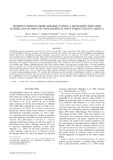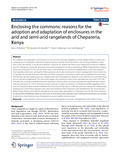Location
Our Vision is to be a world-class university committed to scholarly excellence.
Our Mission is to provide quality university education and training and to embody the aspirations of the Kenyan people and the global community through creation, preservation, integration, transmission and utilization of knowledge.
Core Values
In order to realize the above vision and mission, certain shared values shall be nurtured. There is great need for the University to be guided by the right values derived from the virtues and moral standards of the Kenyan and wider society.
Core Functions
Teaching and Learning: The university offers innovative , relevant and market driven academic programmes , both at undergraduate and postgraduate levels with inbuilt quality control systems the university also provides an environment and policy framework for undertaking high quality and relevant research
Members:
Resources
Displaying 56 - 60 of 298Enclosing the commons: reasons for the adoption and adaptation of enclosures in the arid and semi-arid rangelands of Chepareria, Kenya
The adoption and adaptation of enclosures in the arid and semi-arid rangelands of sub-Saharan Africa is driven and
sustained by a combination of factors. However, reviews indicate that these factors cannot be generalized, as they
tend to be case specific. A study was therefore conducted to explore the history and reasons for enclosure establishment
in Chepareria, a formerly degraded communal rangeland in north-western Kenya. While Vi-Agroforestry Organization
accounting for 52.5 % was the main source of knowledge on enclosure establishment; it has now emerged
Investigating viability of the premium influenced land agro-usage structure for production of African leafy vegetables in Vihiga and Jinja
Land subdivision has reduced land for agricultural production resulting in its intensive cultivation. This has lowered soil fertility which has contributed to reduction in the diversity of African Leafy Vegetables thus restricting the otherwise traditional dietary diversity that was once beneficial to smallholder farmers. As land continues to decline, there needs to be some impetus in place that can retain the diversity of African Leafy Vegetables.
Benefits Derived from Rehabilitating a Degraded Semi-Arid Rangeland in Private Enclosures in West Pokot County, Kenya
Rehabilitating degraded rangelands using enclosures offers various benefits to agro-pastoral households. However, enclosure benefits cannot be generalized as there are variations across dryland ecosystems and societies. This study assessed the qualitative and quantitative benefits derived from rehabilitating degraded rangelands using private enclosures in Chepareria, West Pokot County, Kenya.
Social- economics influence on indigenous poultry production project in Kenya. A case of Machakos indigenous poultry.
Purpose:
The purpose of the study was to analyze the Social
-
economics influence on project
implementation by determining factors that influence indigenous poultry production. The study
would then give recommendations to the relevant authorities and the indigenous
poultry keepers to
address tho
se factors aimed at increasing i
ndigenous poultry production
.
Findings:
The study showed that land size which was on average 1.1 had a significant influence on
Enclosing the commons: reasons for the adoption and adaptation of enclosures in the arid and semi-arid rangelands of Chepareria, Kenya
The adoption and adaptation of enclosures in the arid and semi-arid rangelands of sub-Saharan Africa is driven and
sustained by a combination of factors. However, reviews indicate that these factors cannot be generalized, as they
tend to be case specific. A study was therefore conducted to explore the history and reasons for enclosure establishment
in Chepareria, a formerly degraded communal rangeland in north-western Kenya. While Vi-Agroforestry Organization
accounting for 52.5 % was the main source of knowledge on enclosure establishment; it has now emerged






